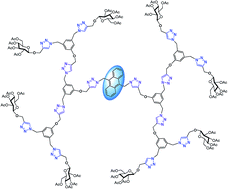Ayyavoo Kannan and Perumal Rajakumar
RSC Adv., 2015,5, 51834-51840
DOI:
10.1039/C5RA07901B,
Communication
Anthracene conjugated blue light emitting glycodendrimers 1, 2 and 3 were synthesized using Cu(I) catalyzed click chemistry. All of the anthracene conjugated blue light emitting glycodendrimers have enhanced photophysical, electrochemical and laser properties, from the lower to the higher generation dendrimers. Blue light emitting higher generation glycodendrimer 3 shows a longer life time (11.2 ns) than the lower generation glycodendrimers 1 and 2 due to the presence of a larger number of triazole bridging units and multivalent glucose units.
